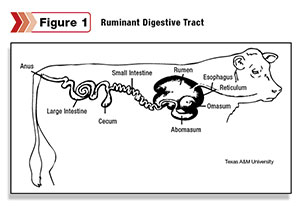 1. A cow’s digestive system and processes
1. A cow’s digestive system and processes
December 2012 issue
Click here to read the original article.
The biggest hit online in 2013 was Robert Fears’ last Progressive Cattleman article of 2012, which placed a priority on healthy ruminant digestion by explaining the tract of the bovine animal.
Dr. Joe Paschal of Texas A&M AgriLife Extension’s method to explain the tract was to pull a digestive tract in front of an audience and lay the organs on a table in orderly fashion, explaining how a cow digests food, starting with the esophagus. In the end, it takes one to three days for food to pass through the animal, depending on what she eats.
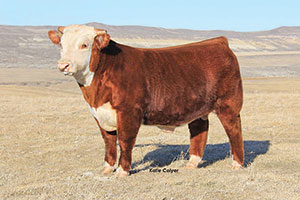 2. Idaho bull takes in record bid
2. Idaho bull takes in record bid
June 2013 issue
Click here to read original article.
A new stud took the seedstock world by storm in February, when Colyer Hereford & Angus of Idaho sold a prize-winning horned Hereford for $600,000 at its annual sale.
Named C Miles McKee after renowned Kansas State University herdsman and professor Miles McKee, the 13-month-old bull went for three-quarters interest to a syndicate that included two operations, one in Iowa and another in Oklahoma.
Kyle Colyer, a manager at Colyers Hereford & Angus, said the bull sale was linked to a KSU classroom, where McKee himself could watch the sale unfold.
According to the World Record Academy website, the $600,000 price tag almost doubled the previous Guinness world record of $301,000 for a cattle sale.
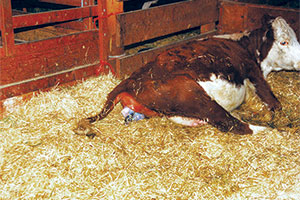 3. When will she calve?
3. When will she calve?
January 2013 issue
Click here to read the original article.
Do cows in your herd start calving just before a storm?
What about dropping temperatures or a dip in the barometer?
Does a fully developed udder mean calving is imminent?
Heather Thomas’ article in our calving issue answered a few of these questions (the answers, by the way, are yes, yes and yes).
Even with the growth of technology in today’s herd health research and reproduction science, there are still proven telltale signs that help the cow-calf producer know when the calf is on the way.
Some key tips the article shared:
- When teats begin to fill, calving usually happens within 24 hours.
- Mucus discharge from a softened cervical plug is another indicator.
- If your cow is docile and lets you walk up and scratch pelvic ligaments, see if the area between the tailhead and pinbone is sunken.
If they’re relaxed, expect a calf within 12 hours.
 4. Integrating mobile apps into ranch management
4. Integrating mobile apps into ranch management
January 2013 issue
Click here to read the original article.
Robyn Scherer’s article on mobile app usage among cattle ranchers offered five samplings of apps finding a place in the hands of producers.
Apps featured included some for data entry, breeding, EPDs, auction prices and bookkeeping.
5. Challenges frame 2013’s first meat export report
Published March 18, 2013
Click here to read the original article.
The first export news of 2013 showed beef exports holding steady with trends from the previous year as values jumped and volume declined.
U.S. Meat Export Federation CEO Phillip Seng warned that limited access to Saudi Arabia and Russia would create issues, but greater sales to Hong Kong and Japan bode well for the year.
So with 2013 behind us, just how well did the export and global trade picture hold?
Starting with Japan, through August, the volume of U.S. beef headed there went up 53 percent (to 166,884 metric tons) and increased 38 percent in value (to $990.9 million).
The eight-month totals showed volume to Mexico down 7 percent (to 130,897 metric tons) and down 5 percent in value (to $559.7 million).
Exports to Canada, however, were climbing – up 9.3 percent in volume (15,355 metric tons) and 7.6 percent in value ($104.6 million).
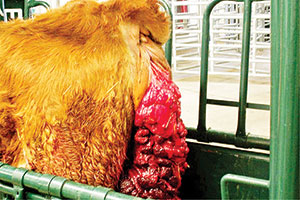 6. The three P’s in a calving 911
6. The three P’s in a calving 911
February 2013 issue
Click here to read the original article.
Calving season can often be synonymous with emergency prep – as producers are on their toes to help cows and their calves in need.
This article by Heather Thomas explains those three conditions that are frequently the most dire events for dystocia and post-calving recovery – prolapse, retained placenta and paralysis.
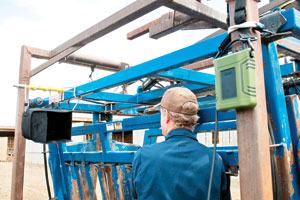 7. Pregnancy testing: New technology provides several options
7. Pregnancy testing: New technology provides several options
November 2012 issue
Click here to read original article.
For producers looking to go beyond preg-checking with the vet, Heather Thomas highlighted those technology options that are emerging in today’s cow-calf segment for efficient pregnancy testing:
• Extension-arm ultrasound
• Blood testing
• Milk testing
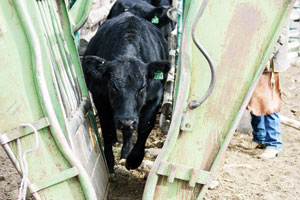 8. Easy steps to designing
8. Easy steps to designing
cattle-handling facilities
November 2012 issue
Click here to read the original article.
Deke Alkire of the Noble Foundation shared key factors that determine the safety and efficiency of cattle-handling equipment, and ways to enhance low-stress animal management.
• Location – Find areas away from roads, where pasture converge
• Size and layout – Consider future needs and allow for growth
• Crowding areas – Remember solid sides enhance movement
• Squeeze chutes – The key is the safety and ease; try them out first
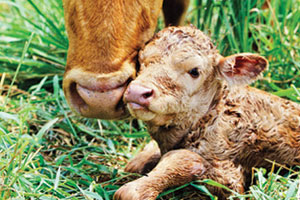 9. Helping the newborn calf get a good start
9. Helping the newborn calf get a good start
February 2013 issue
Click here to read the original article.
Update from the author: Dr. Jack Whittier, beef cattle extension specialist, Colorado State University
Our previous article mentioned that first-calf heifers have no experience in the “mother business” and must allow their innate instincts to take over.
Humans can assist with this by assuring that the heifer has a suitable place for this bonding to occur.
The first few moments after delivering the calf can be important for a heifer to discover and begin to mother her calf. Interference from us or other animals can distract her and delay this process.
If the heifer required assistance for calving, put her and the calf in a secluded area of the calving barn with limited space, then move away and let her take over.
Keep dogs, other cows, calves and other distractions away so that she does not feel threatened or stressed during this bonding period.
If the heifer has calved on her own out in the pasture, chances are that she found a secluded spot with protection, and leaving her alone for several hours is generally the best practice.
Assuming you can observe that the calf will stand and nurse during this early bonding time period, nature has a way of accomplishing the “mother business” training.
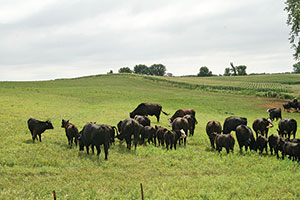 10. Estimating carrying capacity: How many cows can I graze?
10. Estimating carrying capacity: How many cows can I graze?
March 2013 issue
Click here to read the original article.
Jason Ahola with Colorado State University’s Beef Management Systems provided a thorough analysis to calculate an operation’s carrying capacity for grazing animals, with considerations for the variable forages.
Update from author
If drought conditions improve in the coming year, what are some easy ways to boost carrying capacity?
One thing many producers learned during the recent (and in many places still “current”) drought was the need to develop a risk-management strategy to deal with drought.
In some cases this might involve keeping some pasture land in “storage” as backup forage supply, possibly via stockpiled forage.
Or, adding a stocker component to a cow/calf operation allows the purchase of yearlings to graze excess grass, or no purchases if a drought is present.
However, even if drought conditions improve next year, producers should take their time re-stocking cattle and move forward with grazing slowly only after adding a drought management plan to their operation.
In addition, it’s crucial to not over-graze plants immediately after a drought, since they will likely still be stressed and slow-growing in spring due to last summer’s drought.
In terms of increasing carrying capacity of post-drought pastures, some options do exist.
These include:
1. Use of portable/temporary cross fencing to enable pastures to be rested (and thus will increase harvest efficiency by 5 to 15 percentage points, and force grazing distribution into areas not well-grazed previously.
2. Development of water sources to improve grazing distribution (either via piping water, use of natural springs, giving stream access, using stock ponds, etc.
3. Use of fertilizer, although the cost/benefit of this decision needs to be closely evaluated due to relatively high fertilizer costs.
4. Strategic weed management if considerable spring precipitation leads to post-drought weed-infested pastures.
5. Promoting diversity among plant communities via targeted grazing, seeding, and other strategies. Ultimately, it’s best to begin planning early – green grass is still several months away! ![]()






